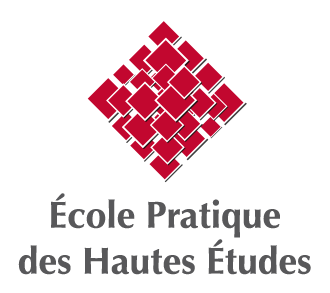
École pratique des hautes études
The École pratique des hautes études (French pronunciation: [ekɔl pʁatik de ot.z‿etyd]), abbreviated EPHE, is a French postgraduate top level educational institution, a Grand Établissement.
Type
1868
Hubert Bost (since 2013)
EPHE is a constituent college of the Université PSL (together with ENS Ulm, Paris Dauphine or Ecole des Mines). The college is closely linked to École française d'Extrême-Orient and Institut français du Proche-Orient.
Prominent researchers in military strategy have taught in EPHE in the past such as Hervé Coutau-Bégarie.[1] In addition, researchers in natural sciences (including neurosciences and chemistry) teach at EPHE (among them Jean Baptiste Charcot and Marcellin Berthelot).
Overview[edit]
The EPHE brings together 260 faculty members and about 3,000 students/attenders into three core departments called “Sections” : Earth and Life Sciences, Historical and Philological Sciences, and Religious Sciences.[2]
It has headquarters in Paris, and has several campuses across France (Paris and its region, Nancy, Dijon, Lyon, Grenoble, Montpellier, Perpignan, Toulouse, Bordeaux, Caen, Dinard, French Polynesia).[3] Teaching and research in human sciences are conducted in Paris, notably at the Sorbonne, the historical house of the former University of Paris and in the building of Maison des Sciences de l'Homme.[4]
The college provides Master's and Doctorate degrees, and the postdoctoral Habilitation à Diriger des Recherches. The School also offers its specific postgraduate degrees – the “Diplôme EPHE” and the “Diplôme post-doctoral” – as well as joint degrees with other universities.
The EPHE maintains extensive cooperative exchanges with universities and research institutions. Priority areas of cooperation are in Europe, the Mediterranean, Middle-East and Asia.
History of EPHE[edit]
The École pratique des hautes études was established by imperial decree on 31 July 1868 at the initiative of Victor Duruy, then Minister of Education under Emperor Napoleon III. Its purpose was to introduce research in academia and, more importantly, to promote academic training through research. It was intended to promote a practical form of scholarship designed to produce knowledge and to be taught in seminars and laboratories, as was being practiced in Germany at the time. Faculty members were to be dedicated, available to students and others for collaboration, accessible, and advance a form of education dependent on a framework of a direct relationship between the master and his disciple.
The School originally had four Sections: Mathematics (I); Physics and Chemistry (II); Natural Sciences and Physiology (III); Philological and Historical Sciences (IV). An Economics Section was added in 1869, but was not developed. Section V, Religious Sciences, was added in 1886.
Section VI, called Economic and Social Sciences, was founded after the Second World War. This section included the study of anthropology, and the French made substantial contributions to these fields, particularly in the structuralism of Claude Lévi-Strauss and others. Their scholars were doing research in South America, Africa and Southeast Asia. There was also research in ethnopsychoanalysis and ethnopsychiatry, particularly by Georges Devereux, who joined the Section in 1963 and influenced more than a generation of scholars.[5] In 1975 Section VI was separated to establish a new school, the École des hautes études en sciences sociales (EHESS).
The institution has been reorganized into three Sections: Earth and Life Sciences, Historical and Philological Sciences, Religious Sciences. Many renowned scholars have lectured at the EPHE or worked in its laboratories.[6] We may cite the following:
Émile Benveniste (1928-1975), Fernand Braudel (1938-1953), Claude Bernard, André Berthelot (Vice-President), Marcellin Berthelot, Michel Bréal (1893-1913), Paul Broca, Jean-Baptiste Charcot, Henry Corbin (1938-1977), Georges Dumézil (1933-1967), Lucien Febvre (1943-1947), Étienne Gilson (1930-1941), Marcel Granet (1930-1939), Joseph Halévy (1887-1916), Bernard Halpern, Alexandre Kojève (1933-1939), Alexandre Koyré (1931-1961), Camille-Ernest Labrousse (1936-1952), Claude Lévi-Strauss (1950-1967), Sylvain Lévi, Alfred Loisy, Auguste Longnon (1887-1911), Gaston Maspero (1872-1915), Louis Massignon (1932-1957), Marcel Mauss (1930-1938), Gabriel Monod (1887-1911), Gaston Paris (1887-1904), Lucie Randoin, Jean Rouch (1959-1992), Émile Roux, Ferdinand de Saussure, Rolf Stein, William Henry Waddington, Henri Wallon...
Recent developments[edit]
Since 2006, the EPHE has been setting up specialized centers which draw on the same scientific resources of the Sections, but whose primary purpose is to develop disciplinary expertise and vocational training, and to disseminate scholarly knowledge.
Three institutes have been established to date : The European Institute of Religious Sciences (IESR),[7] the Pacific Coral Reef Institute (IRCP) and the Transdisciplinary Institute for the Study of Aging (ITEV).
More recently the EPHE has undertaken, as one of nine project sponsors, to create a new research campus in the human and social sciences, the “Campus Condorcet”.[8] Finally, the school has joined PSL, Paris Sciences et Lettres in December 2014.